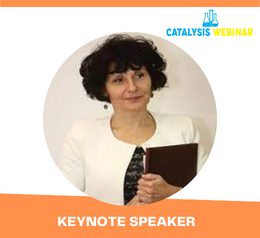Scholars International Webinar on
Catalysis, Chemical Engineering & Technology
THEME: "Contemporary Advances and Innovations in Catalysis and Chemical Engineering Research"
 25-26 Nov 2021
25-26 Nov 2021  Online | Virtual
Online | Virtual THEME: "Contemporary Advances and Innovations in Catalysis and Chemical Engineering Research"
 25-26 Nov 2021
25-26 Nov 2021  Online | Virtual
Online | Virtual 
National Institute of Chemistry and University of Novo Gorica, Slovenia
Title: Engineering photocatalysts for clean air
Prof.
Dr. Nataša Novak Tušar has been the head of the Laboratory of Environmental
Science and Engineering at the Department of Inorganic Chemistry and Technology
at the National Institute of Chemistry in Ljubljana since 2020. Since 2018 she
has been a full professor and director of the PhD program "Materials"
at University Nova Gorica, Slovenia. After obtaining her PhD in Chemistry at
University of Ljubljana, she was Individual Marie Curie Fellow at the
synchrotron ELETTRA and at the University of Trieste, Italy, from 2003-2004.
She is a member of the governing bodies of ENMIX (European Nanoporous Materials
Institute of Excellence) and EFCATS (European Federation of Catalysis
Societies).
In today’s world,
clean air is one of the top priorities of humanity due to human health and
climate change. Air pollution refers to the release of pollutants into the air
from industrial processes, transportation, and consumer products. Both
controlling the sources of pollution and air cleaning are important for
improving air quality. The lecture focuses on the engineering of low-cost and
environmentally friendly photocatalysts for indoor air cleaning. Titanium dioxide (TiO2)
is the most used material for mentioned application due to its
interesting characteristics: low cost, high stability, shows high
photocatalytic activity, it can promote ambient temperature oxidation of the
major class of organic pollutants. However, due to the
hindered applications of TiO2 as non-supported systems for
photocatalytic air cleaning, design and development of TiO2 supported
systems are very important.
Common support materials are SiO2, Al2O3, zeolites
(aluminosilicates), carbon etc. These materials exhibit high specific surface
areas, high porosities in a variety of pore sizes, and high thermal and
mechanical stability, while they are mostly chemically inert. Here, an overview of the design
and development of mechanically stable TiO2-SiO2 coatings
for removal of the volatile organic pollutants from the air is presented. Engineering
of photocatalysts consisting of a) SiO2 supported TiO2
working under UV light and b) SiO2 supported TiO2
functionalized with transition metals working under visible light is discussed.